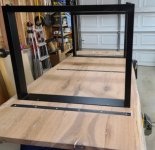I am planning on building a kitchen table from old lumber that has sentimental value for my friend.
I've seen on YouTube where people router a slotted C-Chanel under the table top for support and expansion contraction issues.
If I use Domino-XL and wood glue for joining the boards lengthwise edge grain is the C-Chanel needed?
Thanks
I've seen on YouTube where people router a slotted C-Chanel under the table top for support and expansion contraction issues.
If I use Domino-XL and wood glue for joining the boards lengthwise edge grain is the C-Chanel needed?
Thanks

